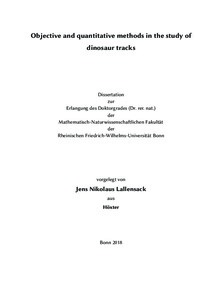Objective and quantitative methods in the study of dinosaur tracks

Objective and quantitative methods in the study of dinosaur tracks

| dc.contributor.advisor | Sander, Martin P. | |
| dc.contributor.author | Lallensack, Jens Nikolaus | |
| dc.date.accessioned | 2020-04-26T10:19:36Z | |
| dc.date.available | 2020-04-26T10:19:36Z | |
| dc.date.issued | 05.02.2019 | |
| dc.identifier.uri | https://hdl.handle.net/20.500.11811/7866 | |
| dc.description.abstract | This dissertation develops and employs objective and quantitative methods for the analysis of dinosaur tracks. Tracks are—besides the familiar bones and teeth—a crucial data source for inferences on dinosaur biology and evolution. Tracks allow for insights that cannot be directly obtained from bones and teeth. Most obviously, their nature as life traces allows for inferences on behavior, posture, gait, and speed. Track data, however, are often more ambiguous than data derived from bones. Footprint margins, for example, are difficult to define objectively, and footprint shape is the result of a combination of many factors including anatomy, substrate, and behavior, complicating their interpretation. Although quantitative methods are needed to constrain this ambiguity and to effectively analyze the often non-discrete characters of footprint shape, the study of dinosaur tracks is still a largely subjective endeavor. This dissertation aims to demonstrate the utility of these methods for studying dinosaur tracks, not only to improve on objectivity and reproducibility of results, but also to gain novel insights into dinosaur biology and evolution. In a case study of Lower Cretaceous theropod and ornithopod trackways from Münchehagen, Germany, geometric morphometric analysis is employed to quantify footprint shape variation within trackways, revealing that many shape features may not reflect foot anatomy. Furthermore, inferences on the discrimination between the footprints of theropod and ornithopod trackmakers and between footprints of the left and right foot are made (chapter 2). A larger (n=303) sample of tridactyl footprints from all over the world was analyzed using an approach combining geometric morphometrics and linear and angular measurements, revealing that footprint shape carries a strong functional signal. Cursorial, graviportal, and stabilizing adaptations may be differentiated based on footprints. Furthermore, footprint size evolution is analyzed separately for theropods and ornithischians, revealing reverse trends (chapter 3). In an attempt to provide a solution for the vexing problem of defining objective footprint margins, a program was written that is, for the first time, able to compute outlines automatically from 3D-models of footprints, providing the basis for fully objective shape analyses (chapter 4). An extensive sauropod tracksite from the Middle Jurassic of Morocco was analyzed in detail, revealing trackways with laterally orientated manual impressions, which is rare in sauropods. Statistical analysis of trackway parameters of these and other trackways from around the world (n=79) demonstrates that the manus orientation is determined by both relative locomotion speed (and thus, behavior) and the position of the center of mass (anatomy). Furthermore, the gleno-acetabular length is evaluated as an alternative size proxy for quadrupedal trackways, and attempts are made to quantify trackway asymmetries and to produce trackway mean configurations (chapter 5). The synapomorphy-based approach, sometimes considered the most rigorous objective approach for trackmaker identification, is used to identify a sauropod trackway from the Late Triassic of Greenland, currently constituting the most unambiguous evidence for sauropods before the Jurassic (chapter 6). Another trackway from the Late Triassic of Lesotho shows somewhat sprawling forelimbs, and thus may pertain to a recently identified group of large and quadrupedal non-sauropod sauropodomorphs, the Lessemsauridae (chapter 7). The state of research is reviewed, identifying five principal challenges that add significant ambiguity to previous interpretations and can possibly be accounted for by the use of objective and quantitative methods. It is argued that currently employed ichnotaxonomy lacks an objective basis, but that other approaches to the study of tracks, in particular functional interpretations, may add more to our understanding of dinosaurs than previously recognized (chapter 8). | en |
| dc.language.iso | eng | |
| dc.rights | In Copyright | |
| dc.rights.uri | http://rightsstatements.org/vocab/InC/1.0/ | |
| dc.subject | Dinosaurier | |
| dc.subject | Fußspuren | |
| dc.subject | Mesozoikum | |
| dc.subject | Quantitative Datenanalyse | |
| dc.subject | Dinosaur | |
| dc.subject | Footprints | |
| dc.subject | Tracks | |
| dc.subject | Mesozoic | |
| dc.subject | Quantitative data analysis | |
| dc.subject.ddc | 560 Paläontologie | |
| dc.title | Objective and quantitative methods in the study of dinosaur tracks | |
| dc.type | Dissertation oder Habilitation | |
| dc.publisher.name | Universitäts- und Landesbibliothek Bonn | |
| dc.publisher.location | Bonn | |
| dc.rights.accessRights | openAccess | |
| dc.identifier.urn | https://nbn-resolving.org/urn:nbn:de:hbz:5n-53507 | |
| ulbbn.pubtype | Erstveröffentlichung | |
| ulbbnediss.affiliation.name | Rheinische Friedrich-Wilhelms-Universität Bonn | |
| ulbbnediss.affiliation.location | Bonn | |
| ulbbnediss.thesis.level | Dissertation | |
| ulbbnediss.dissID | 5350 | |
| ulbbnediss.date.accepted | 05.10.2018 | |
| ulbbnediss.institute | Mathematisch-Naturwissenschaftliche Fakultät : Fachgruppe Erdwissenschaften / Steinmann-Institut für Geologie, Mineralogie und Paläontologie | |
| ulbbnediss.fakultaet | Mathematisch-Naturwissenschaftliche Fakultät | |
| dc.contributor.coReferee | Martin, Thomas |
Files in this item
This item appears in the following Collection(s)
-
E-Dissertationen (4337)




